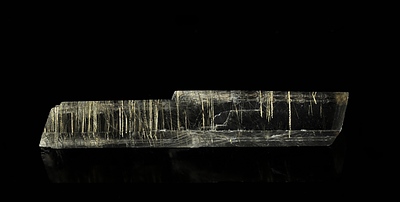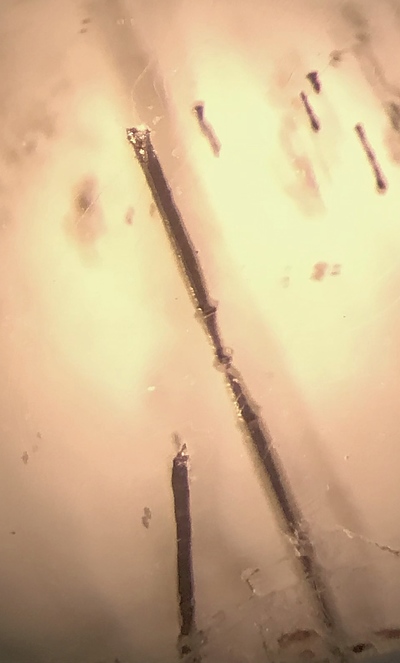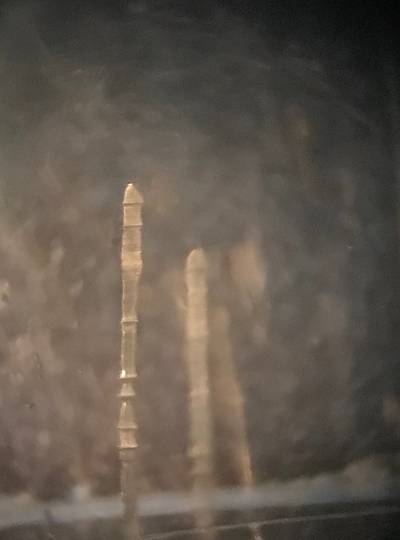Chalcopyrite : CuFeS2
Calcite : CaCO3
As recorded:
Madawaska Mine, Faraday Township, Hastings County, Ontario, Canada

Photo added to mindat.org
“A calcite cleavage with chalcopyrite-thread inclusions.
Collected by Doug Scott in 1960 on the second level of the Faraday Uranium Mine at the time when the mine was shutting down and specimen collectors were allowed in.
This cleavage came off a foot long clear calcite crystal with the same inclusions on one side during transportation from Bancroft to Doug's then home in Markham.
Unfortunately the big crystal is no longer in Doug's possession. He kindly gifted this remaining cleavage to me.
Cat.#633”
John R. Montgomery - 22nd September 2019

Photo added to mindat.org
“A calcite cleavage with chalcopyrite-thread inclusions.
Collected by Doug Scott in 1960 on the second level of the Faraday Uranium Mine at the time when the mine was shutting down and specimen collectors were allowed in.
This cleavage came off a foot long clear calcite crystal with the same inclusions on one side during transportation from Bancroft to Doug's then home in Markham.
Unfortunately the big crystal is no longer in Doug's possession. He kindly gifted this remaining cleavage to me.
Cat.#633”
John R. Montgomery - 22nd September 2019

Photo added to mindat.org
“A calcite cleavage with chalcopyrite-thread inclusions.
Collected by Doug Scott in 1960 on the second level of the Faraday Uranium Mine at the time when the mine was shutting down and specimen collectors were allowed in.
This cleavage came off a foot long clear calcite crystal with the same inclusions on one side during transportation from Bancroft to Doug's then home in Markham.
Unfortunately the big crystal is no longer in Doug's possession. He kindly gifted this remaining cleavage to me.
Cat.#633”
John R. Montgomery - 22nd September 2019

Photo added to mindat.org
“ End to end stacked-chains of malformed disphenoid chalcopyrite crystals seen through a clear calcite cleavage (4.7cm.).
The best example of this unusual form is the left most chain in this child photo https://www.mindat.org/photo-1001929.html (note that the end crystal comes to a point and the crystals lower down appear to be stacked versions of somewhat elongated examples of the same thing, point to flat base)
Some of these crystal inclusions have a dark “core” surrounded by a lighter "rind". The "core" is the chalcopyrite and the “rind” is a sheath of tiny bubbles of the original solution trapped in the calcite. This photo is the best example.
Collected by Doug Scott in 1960 on the second level of the Faraday Uranium Mine at the time when the mine was shutting down and specimen collectors were allowed in.
This cleavage broke off from a foot-long clear calcite crystal (with the same inclusions on one side) while being transported from Bancroft to Doug's then home in Markham, Ontario. Unfortunately the big crystal is no longer in Doug's possession. He kindly gifted this remaining cleavage to me.
Cat.#633”
John R. Montgomery - 22nd September 2019

Photo added to mindat.org
“ End to end stacked-chains of malformed disphenoid chalcopyrite crystals seen through a clear calcite cleavage (4.7cm.)
The best example of this unusual form is the left most chain in this child photo https://www.mindat.org/photo-1001929.html (note that the end crystal comes to a point and the crystals lower down appear to be stacked versions of somewhat elongated examples of the same thing, point to flat base)
Some of these crystal inclusions have a dark “core” surrounded by a lighter "rind". The "core" is the chalcopyrite and the “rind” is a sheath of tiny bubbles of the original solution trapped in the calcite. see child photo https://www.mindat.org/photo-1001854.htm
Collected by Doug Scott in 1960 on the second level of the Faraday Uranium Mine at the time when the mine was shutting down and specimen collectors were allowed in.
This cleavage broke off from a foot-long clear calcite crystal (with the same inclusions on one side) while being transported from Bancroft to Doug's then home in Markham, Ontario. Unfortunately the big crystal is no longer in Doug's possession. He kindly gifted this remaining cleavage to me.
Cat.#633”
John R. Montgomery - 22nd September 2019

Photo added to mindat.org
“ End to end stacked-chains of malformed disphenoid chalcopyrite crystals seen through a clear calcite cleavage (4.7cm.)
The best example of this unusual form is the left most chain in this child photo https://www.mindat.org/photo-1001929.html (note that the end crystal comes to a point and the crystals lower down appear to be stacked versions of somewhat elongated examples of the same thing, point to flat base)
Some of these crystal inclusions have a dark “core” surrounded by a lighter "rind". The "core" is the chalcopyrite and the “rind” is a sheath of tiny bubbles of the original solution trapped in the calcite. see child photo https://www.mindat.org/photo-1001854.htm
Collected by Doug Scott in 1960 on the second level of the Faraday Uranium Mine at the time when the mine was shutting down and specimen collectors were allowed in.
This cleavage broke off from a foot-long clear calcite crystal (with the same inclusions on one side) while being transported from Bancroft to Doug's then home in Markham, Ontario. Unfortunately the big crystal is no longer in Doug's possession. He kindly gifted this remaining cleavage to me.
Cat.#633”
John R. Montgomery - 22nd September 2019

Photo added to mindat.org
“ End to end stacked-chains of malformed disphenoid chalcopyrite crystals seen through a clear calcite cleavage (4.7cm.).
The best example of this unusual form is the left most chain in this child photo https://www.mindat.org/photo-1001929.html (note that the end crystal comes to a point and the crystals lower down appear to be stacked versions of somewhat elongated examples of the same thing, point to flat base)
Some of these crystal inclusions have a dark “core” surrounded by a lighter "rind". The "core" is the chalcopyrite and the “rind” is a sheath of tiny bubbles of the original solution trapped in the calcite. see child photo https://www.mindat.org/photo-1001854.htm
Collected by Doug Scott in 1960 on the second level of the Faraday Uranium Mine at the time when the mine was shutting down and specimen collectors were allowed in.
This cleavage broke off from a foot-long clear calcite crystal (with the same inclusions on one side) while being transported from Bancroft to Doug's then home in Markham, Ontario. Unfortunately the big crystal is no longer in Doug's possession. He kindly gifted this remaining cleavage to me.
Cat.#633”
John R. Montgomery - 23rd September 2019

Photo added to mindat.org
“ End to end stacked-chains of malformed disphenoid chalcopyrite crystals seen through a clear calcite cleavage (4.7cm.)
The best example of this unusual form is the left most chain in this child photo (note that the end crystal comes to a point and the crystals lower down appear to be stacked versions of somewhat elongated examples of the same thing, point to flat base)
Some of these crystal inclusions have a dark “core” surrounded by a lighter "rind". The "core" is the chalcopyrite and the “rind” is a sheath of tiny bubbles of the original solution trapped in the calcite. see child photo https://www.mindat.org/photo-1001854.htm
Collected by Doug Scott in 1960 on the second level of the Faraday Uranium Mine at the time when the mine was shutting down and specimen collectors were allowed in.
This cleavage broke off from a foot-long clear calcite crystal (with the same inclusions on one side) while being transported from Bancroft to Doug's then home in Markham, Ontario. Unfortunately the big crystal is no longer in Doug's possession. He kindly gifted this remaining cleavage to me.
Cat.#633”
John R. Montgomery - 23rd September 2019

Photo added to mindat.org
“ End to end stacked-chains of malformed disphenoid chalcopyrite crystals seen through a clear calcite cleavage (4.7cm.)
The best example of this unusual form is the left most chain in this child photo https://www.mindat.org/photo-1001929.html (note that the end crystal comes to a point and the crystals lower down appear to be stacked versions of somewhat elongated examples of the same thing, point to flat base)
Some of these crystal inclusions have a dark “core” surrounded by a lighter "rind". The "core" is the chalcopyrite and the “rind” is a sheath of tiny bubbles of the original solution trapped in the calcite. see child photo https://www.mindat.org/photo-1001854.htm
Collected by Doug Scott in 1960 on the second level of the Faraday Uranium Mine at the time when the mine was shutting down and specimen collectors were allowed in.
This cleavage broke off from a foot-long clear calcite crystal (with the same inclusions on one side) while being transported from Bancroft to Doug's then home in Markham, Ontario. Unfortunately the big crystal is no longer in Doug's possession. He kindly gifted this remaining cleavage to me.
Cat.#633”
John R. Montgomery - 23rd September 2019
No-one has added this to their favourites.
10,443,355 minIDs have been issued as of 25th Apr 2024 9:22 am UTC
